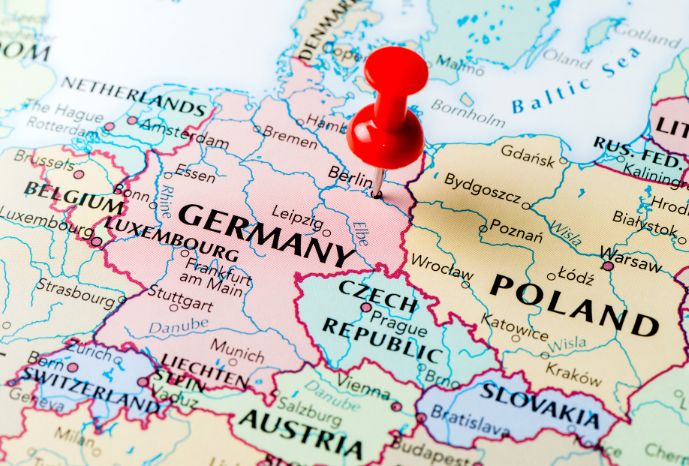
E-commerce in Germany: Key Trends and Challenges in 2025
The German e-commerce market is one of the largest in Europe. In 2024, it reached a turnover of €80.6 billion, representing a year-on-year increase of 1.1%. It is expected to grow to $88.4 billion by 2028, with an average annual growth rate (CAGR) of 8.29% (GlobeNewswire). This growth is driven by increasing consumer spending, digitalization, and the expansion of logistics capacities.
The German e-commerce market is one of the largest in Europe. In 2024, it reached a turnover of €80.6 billion, representing a year-on-year increase of 1.1%. It is expected to grow to $88.4 billion by 2028, with an average annual growth rate (CAGR) of 8.29% (GlobeNewswire). This growth is driven by increasing consumer spending, digitalization, and the expansion of logistics capacities.
Table of contents
Changes in Consumer Behavior After COVID-19
The COVID-19 pandemic significantly accelerated the shift of German consumers to online shopping. In 2024, 99% of German adults shopped online, with 39% doing so at least once a week (reuters.com).
Today, customers expect fast delivery and easy online payment options. This trend is especially visible among younger generations, who prefer modern payment methods such as digital wallets or instant bank transfers.
Additionally, up to 45% of German customers consider fast delivery a key factor in their purchasing decisions. In Germany, it has become standard to deliver goods to customers' homes within 24 hours (Ecommerce Germany). Transparency in delivery times and real-time tracking are also expected, prompting German e-shops to invest in advanced logistics solutions.
Free shipping is another crucial factor; 40% of German customers state that free delivery is decisive for completing a purchase. Many e-shops, therefore, offer it automatically, as German consumers already consider it standard. Companies like Zalando and About You provide free delivery and returns, contributing to the high return rate.
Companies that offer free shipping may lose competitiveness unless they provide another significant benefit, such as faster delivery or exclusive customer service.
Digitalization and Automation
German e-shops are leaders in digitalization. Advanced technologies, such as artificial intelligence (AI), are used for personalizing offers, analyzing shopping behavior, and optimizing logistics processes. For instance, Zalando launched an AI assistant in 2023 to help customers choose products. This system recommends items based on individual preferences, past purchases, and current trends (Zalando Corporate).
Moreover, German e-shops increasingly use AI to manage inventory more efficiently and predict demand, helping them minimize costs while speeding up order fulfillment.
Returns and Their Impact
As mentioned earlier, Germany has a high return rate, especially in the fashion segment, where up to 50% of orders are returned.
This trend is partly driven by the possibility of ordering multiple sizes or colors and returning unwanted items. Free returns are common in Germany, lowering barriers to online shopping and increasing customers' willingness to buy. However, this model poses challenges for e-shops, which must efficiently manage logistics and costs associated with returns.
A high return rate can negatively affect e-shop margins, as the costs of shipping, processing, and potential product damage can be significant. Some retailers attempt to address this issue by introducing return fees or improving size guides to reduce the number of returns.
Sustainability and Environmental Trends
Sustainability is becoming a key factor in German e-commerce, both for consumers and companies. Shoppers increasingly prefer eco-friendly packaging and delivery methods, prompting e-shops to implement measures that reduce their carbon footprint.
For example, Zalando has committed to achieving carbon-neutral operations and invested €50 million in sustainable products in 2023. Additionally, German e-shops increasingly use recyclable packaging and collaborate with logistics partners offering climate-neutral shipping.
Another step toward sustainability is the introduction of product return programs that promote reuse and recycling, reducing waste. Some brands also offer second-hand return options, supporting the circular economy and conserving natural resources.
| Indicator | Value |
|---|---|
| E-commerce market size (2024) | €80.6 billion |
| Payment methods | PayPal (80%), credit cards, bank transfers |
| Return rate (fashion industry) | 50% |
| Sustainability | Eco-friendly packaging, carbon-neutral delivery |
What Are German Companies Doing Differently?
German e-commerce companies stand out due to several key aspects:
Advanced digital infrastructure: Major German companies like Zalando and Amazon have sophisticated logistics systems that enable fast delivery, often within 24 hours.
Sustainability: A strong emphasis on eco-friendly products, recyclable packaging, and carbon-neutral delivery.
Advanced data usage: Investments in data analytics for personalized offers and predictive analysis of shopping behavior.
Privacy protection: Strict data protection standards increase customer trust in online shopping.
Omnichannel integration: A seamless combination of online and offline sales channels enhances customer convenience and flexibility.
For businesses planning to enter the German market, it is crucial to invest in technology, sustainability, and customer data protection to succeed in this competitive environment.
Innovation in Germany
The German e-commerce market consists of approximately 300,000 online shops. 62% of these implement omnichannel strategies that combine online and offline sales channels. This approach increases customer convenience and enables more flexible shopping options.
In 2025, the German e-commerce market will continue to establish itself as one of the largest and most advanced in Europe, with a focus on rapid growth, digitalization, and sustainability. The main factors shaping its future include continued digitalization, automation, and increasing consumer demands for speed and flexibility in services. German e-shops are investing in technologies like artificial intelligence (AI) and are increasingly focusing on eco-friendly and sustainable initiatives, responding to the growing demand for environmentally responsible practices.
Challenges such as the high return rate and the need for efficient logistics management will continue to drive companies toward innovation while also presenting opportunities for those that can adapt to changing consumer preferences. Success in the German e-commerce market will depend on a company’s ability to combine cutting-edge technology with sustainable practices and high privacy standards, securing customer trust and loyalty in this increasingly competitive environment.